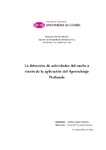Mostrar o rexistro simple do ítem
La detección de actividades del sueño a través de la aplicación del Aprendizaje Profundo
| dc.contributor.advisor | Hernández-Pereira, Elena | |
| dc.contributor.author | Gómez Gutiérrez, Sandra | |
| dc.contributor.other | Enxeñaría informática, Grao en | es_ES |
| dc.date.accessioned | 2021-10-21T18:28:18Z | |
| dc.date.available | 2021-10-21T18:28:18Z | |
| dc.date.issued | 2021 | |
| dc.identifier.uri | http://hdl.handle.net/2183/28704 | |
| dc.description.abstract | [Resumen] La detección de actividades del sueño en la señal del electroencefalograma (EEG) es una tarea fundamental para la clasificación de los estados de sueño. Esta tarea resulta costosa no solo por el elevado número de actividades que existen sino por la dificultad que entraña la identificación de sus características. La aplicación de métodos automáticos para detectar este tipo de actividades está totalmente justificada. La gran mayoría de estos métodos automáticos identifican características de las actividades del sueño y luego las clasifican. En este trabajo, se identifica una de estas actividades, denominada husos de sueño, a través de imágenes obtenidas a partir de la señal de EEG y con la ayuda del Aprendizaje Profundo mediante redes convolucionales. Esta aproximación se compara con la extracción de características sobre la señal de EEG, de nuevo a través de Aprendizaje Profundo mediante redes convolucionales. | es_ES |
| dc.description.abstract | [Abstract] The detection of sleep activities in the electroencephalogram (EEG) signal is a fundamental task for the classification of sleep states. This task is costly not only due to the high number of activities that exist but also because of the difficulty involved in identifying their characteristics. The application of automatic methods to detect this type of activity is fully justified. The vast majority of these automated methods identify characteristics of sleep activities and then classify them. In this work, one of these activities, called sleep spindles, is identified through images obtained from the EEG signal and with the help of Deep Learning through convolutional networks. This approach is compared with the extraction of features on the EEG signal, again through Deep Learning using convolutional networks. | es_ES |
| dc.language.iso | spa | es_ES |
| dc.rights | Atribución-NoComercial-SinDerivadas 3.0 España | es_ES |
| dc.rights.uri | http://creativecommons.org/licenses/by-nc-nd/3.0/es/ | * |
| dc.subject | Aprendizaje profundo | es_ES |
| dc.subject | Clasificación | es_ES |
| dc.subject | Huso de sueño | es_ES |
| dc.title | La detección de actividades del sueño a través de la aplicación del Aprendizaje Profundo | es_ES |
| dc.type | info:eu-repo/semantics/bachelorThesis | es_ES |
| dc.rights.access | info:eu-repo/semantics/openAccess | es_ES |
| dc.description.traballos | Traballo fin de grao. Enxeñaría Informática. Curso 2020/2021 | es_ES |






